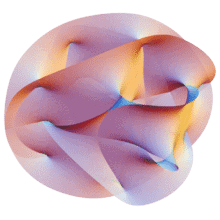USC scientists suggest a connection that could be a huge boost to string theory
Two USC researchers have proposed a link between string field theory and quantum mechanics that could open the door to using string field theory — or a broader version of it, called M-theory — as the basis of all physics.
“This could solve the mystery of where quantum mechanics comes from,” said Itzhak Bars, USC Dornsife College of Letters, Arts and Sciences professor and lead author of the paper.
Bars collaborated with Dmitry Rychkov, his Ph.D. student at USC. The paper was published online on Oct. 27 by the journal Physics Letters.
Rather than use quantum mechanics to validate string field theory, the researchers worked backwards and used string field theory to try to validate quantum mechanics.
In their paper, which reformulated string field theory in a clearer language, Bars and Rychov showed that a set of fundamental quantum mechanical principles known as “commutation rules” may be derived from the geometry of strings joining and splitting.
“Our argument can be presented in bare bones in a hugely simplified mathematical structure,” Bars said. “The essential ingredient is the assumption that all matter is made up of strings and that the only possible interaction is joining/splitting as specified in their version of string field theory.”
Physicists have long sought to unite quantum mechanics and general relativity, and to explain why both work in their respective domains. First proposed in the 1970s, string theory resolved inconsistencies of quantum gravity and suggested that the fundamental unit of matter was a tiny string, not a point, and that the only possible interactions of matter are strings either joining or splitting.
Four decades later, physicists are still trying to hash out the rules of string theory, which seem to demand some interesting starting conditions to work (like extra dimensions, which may explain why quarks and leptons have electric charge, color and “flavor” that distinguish them from one another).
At present, no single set of rules can be used to explain all of the physical interactions that occur in the observable universe.
On large scales, scientists use classical, Newtonian mechanics to describe how gravity holds the moon in its orbit or why the force of a jet engine propels a jet forward. Newtonian mechanics is intuitive and can often be observed with the naked eye.
On incredibly tiny scales, such as 100 million times smaller than an atom, scientists use relativistic quantum field theory to describe the interactions of subatomic particles and the forces that hold quarks and leptons together inside protons, neutrons, nuclei and atoms.
Quantum mechanics is often counterintuitive, allowing for particles to be in two places at once, but has been repeatedly validated from the atom to the quarks. It has become an invaluable and accurate framework for understanding the interactions of matter and energy at small distances.
Quantum mechanics is extremely successful as a model for how things work on small scales, but it contains a big mystery: the unexplained foundational quantum commutation rules that predict uncertainty in the position and momentum of every point in the universe.
“The commutation rules don’t have an explanation from a more fundamental perspective, but have been experimentally verified down to the smallest distances probed by the most powerful accelerators. Clearly the rules are correct, but they beg for an explanation of their origins in some physical phenomena that are even deeper,” Bars said.
The difficulty lies in the fact that there’s no experimental data on the topic — testing things on such a small scale is currently beyond a scientist’s technological ability.
If our reporting has informed or inspired you, please consider making a donation. Every contribution, no matter the size, empowers us to continue delivering accurate, engaging, and trustworthy science and medical news. Independent journalism requires time, effort, and resources—your support ensures we can keep uncovering the stories that matter most to you.
Join us in making knowledge accessible and impactful. Thank you for standing with us!


If the solvency of the Quantum Theory Bank is in doubt, just make it a subsidiary of the String Theory Bank because the String Theory Bank is “TOO BIG TO FAIL”.
Problem Solved!
The solution to these questions will be found when the researchers back away a bit from their individual disciplines, and collaborate with other researches in larger and larger systems. From these combined studies, patterns will emerge, patterns that will be initially observed by those people most knowledgable about their individual disciplines. Once discovered or hinted at, they can be researched and refined.
It’s becoming increasingly important to expand our view, to incorporate the vast knowledge and information that is available, which is constantly in process and changing, in order to understand what has been occurring, and to more accurately predict what changes may take place in the future.